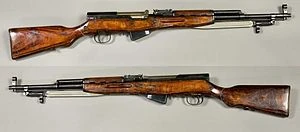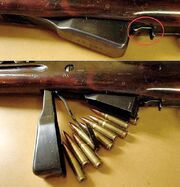{{
Script error: No such module "Namespace detect".
| type = | image = Forumintro1.jpeg | imageright = | class = | style = | textstyle = | text = {{{text}}} | small = | smallimage = | smallimageright = | smalltext = | subst = | date = | name = }}
| SKS | |
|---|---|
 SKS Carbine from the collections of Armémuseum, Stockholm, Sweden | |
| Type | Semi-automatic rifle |
| Place of origin | Soviet Union |
| Service history | |
| In service | Most Communist force countries |
| Production history | |
| Designer | Sergei Gavrilovich Simonov |
| Designed | 1944 |
| Number built | 15,000,000 |
| Variants | Chinese Type 56; Yugoslavian PAP; Romanian SKS; Albanian SKS; East German SKS; (North) Vietnamese SKS; North Korean SKS |
| Specifications | |
| Weight | 3.85 kg (8 lb 8 oz) |
| Length | 1,021 millimetres (Script error: No such module "Math". in), M59/66 length 1,117 millimetres (Script error: No such module "Math". in) |
| Barrel length | 521 millimetres (Script error: No such module "Math". in), M59/66 558.8 millimetres (Script error: No such module "Math". in) |
| Cartridge | 7.62×39mm |
| Action | Short stroke gas piston, tilting bolt, self-loading |
| Rate of fire | Semi-automatic |
| Muzzle velocity | 735 m/s (Script error: No such module "Math". ft/s) |
| Effective range | 500 metres (Script error: No such module "Math". yd) |
| Feed system | 10 round stripper clip-fed or individual round loading |
| Sights | Hooded post front sight, tangent notch rear sight graduated from 100 to 1,000 meters |
The SKS Rifle is a semi-automatic rifle that was designed in the Soviet Union and used in Vietnam by Communist forces.
Development[]
This weapon was developed in the Soviet Union as a replacement for the Mosin Nagant. It was designed to utilize an intermediate round which was the 7.62×39mm round.
Characteristics and specifications[]

Yugoslavian SKS M59/66 with the muzzle formed into a spigot-type grenade launcher, and folding bayonet
The SKS has a conventional carbine layout, with a wooden stock and no pistol grip. Most versions are fitted with an integral folding bayonet which rotates downward from the end of the barrel. Some versions, such as the Yugoslavian-made M59/66 variant, are also equipped with a grenade launching attachment. As with the American M1 carbine, the SKS is shorter and less powerful than the semi-automatic rifles which preceded it: most notably, the Soviet SVT series and the American M1 Garand. The basic design lacks both selective fire capability and a detachable magazine; however, there are aftermarket modifications available which provide the SKS with selective-fire capability (the ability to fire in either semi-automatic or full-automatic mode). Some selective-fire variants were produced in the PRC, and many SKS's have been modified in various ways to accept detachable magazines; however, the basic design of the SKS is semi-automatic and fixed-magazine in nature. The carbine's ten-round box magazine is fed from a stripper clip (see below), and rounds stored in the magazine can be removed by depressing a magazine catch (thus opening the "floor" of the magazine and allowing the rounds to fall out) located forward of the trigger guard.
The notched rear tangent iron sight is adjustable, and is calibrated in hundreds of meters. The front sight is a post adjustable for elevation in the field. Windage adjustment is done by the armory before issue. The battle setting (-П-) places the round within +/-33 cm from the point of aim out to 350 m (380 yd). This "point-blank range" setting allows the shooter to fire the gun at any close target without adjusting the sights. The field adjustment procedure for AK-47, AKM and AK-74 family requires 4 rounds to be placed in a 15 cm group at a distance of 100 meters. Longer settings are intended for area suppression. These settings mirror the Mosin–Nagant and SKS rifles which the AK-47 replaced. This eased transition and simplified training.
Variants[]

Yugoslavian M59/66 with the muzzle formed into a spigot-type grenade launcher and a folding ladder grenade sight behind the front sight.

Chinese Type 56 semi-automatic carbine (Chinese SKS).

An SKS-M

SKS with the magazine closed (top) and open. The magazine release is circled.

A blade-type bayonet in its closed and open positions
- Russian (1949–1956): Early (1949–1951) Spike-style bayonet (1949) instead of blade-style. Squared-off gas block (1949 to early 1950) instead of the rounded one more commonly seen. Spring-return firing pin on early models (1949-early 1951). The gas block had 3 changes: (Squared-off) is the 90-degree angle, that's First stage production, 1949 to early 1950. Second gas block production type: (1950–1951) cut at 45-degree angle. Third gas block production type: (1952-55/56) Rounded inward or Cut Curved inward.
- Soviet Honor Guard: All-chrome metal parts, with a lighter-colored wood stock.
- Chinese Type 56 (1956-): Numerous minor tweaks, including lack of milling on the bolt carrier, partially or fully stamped (as opposed to milled) receivers, and differing types of thumb rest on the take down lever. The Chinese continually revised the SKS manufacturing process, so variation can be seen even between two examples from the same factory. All of the Type 56 carbine rifles have been removed from military service, except a few being used for ceremonial purposes and by local Chinese Militias. Type 56 carbines with serial numbers below 9,000,000 have the Russian-style blade-type folding bayonet, while those 9,000,000 and higher have a "spike" type folding bayonet. Some early examples are known as "Sino-Soviet", meaning they were produced by China, but with cooperation from Russian "advisers" who helped regulate the factories and provided the design specifications.
- Chinese Honor Guard: Mostly, but not all, chromed metal parts. Does not generally have the lighter-colored stock as the Soviet Honor Guard variant.
- Chinese Type 63, 68, 73, 81, 84: Only a close relative to the SKS, these rifles shared features from several east-bloc rifles (SKS, AK-47, Dragunov). AK-47 style rotary bolt and detachable magazine. The Type 68 featured a stamped sheet-steel receiver. The 81 is an upgraded Type 68 with a three-round burst capability, some of which (Type 81-1) have a folding stock. The Type 84 (known as an SKK) returns to semi-auto fire only, is modified to accept AK-47 magazines, and has a shorter 16" paratrooper barrel.
- Chinese commercial production: Blonde wood ("Chu wood"/"Qiu wood" = Catalpa wood)[1] stock instead of dark wood, spike bayonet instead of blade, bayonet retaining bolt replaced with a rivet. Sub-variants include the M21, "Cowboy's Companion", Hunter, Models D/M, Paratrooper, Sharpshooter, and Sporter. Model D rifles used military style stocks and had bayonet lugs (although some were imported minus bayonet, and a small few minus the lug in order to meet changing US import restrictions). Model M rifles had no bayonet lug and used either a thumb hole or Monte Carlo–style stock. Both model D and M used AK-47 magazines and as a result had no bolt hold open feature on the rifle.
- Romanian: Typically nearly identical to the late Russian model.
- Polish SKS: Refurbished Soviet rifles. Polish laminated stocks lack storage area in back of stock for cleaning kit. A few hundred SKS's were given to Poland by the Soviet Union around 1954, SKS rifles still in use in ceremonial units of the Polish Army, Air Force, Navy where they replaced AWT rifles. Honor guards of the Polish Police and Border Guard also use SKS rifles. SKS rifles were never adopted by combat units. In Polish service they are known as ksS which stands for karabin samopowtarzalny Simonowa, Simonov's semi-automatic rifle.
- Yugoslavian PAP M59: Barrel is not chrome-lined. PAP means "Polu-automatska puška" (Semi-automatic rifle) and the rifle was nicknamed "Papovka". Otherwise this rifle is nearly identical to the Russian version.
- Yugoslavian PAP M59/66: Added 22 mm grenade launcher which appears visually like a flash suppressor or muzzle brake on the end of the barrel. Front sight has a fold-up "ladder" for use in grenade sighting (main sights on the A1 version have flip up phosphorus or tritium night sights). When the grenade sight is raised, the gas system is automatically blocked and the action must be manually cycled—rifle grenades must be fired with blank cartridges for safety, and this feature helps ensure that a live round is not loaded from the magazine. The gas system is not automatically unblocked when the sight is folded, however, and must be manually opened to again allow semi-automatic operation.[2] Barrel was not chrome-lined before about 1970. Both the grenade launcher and grenade sight are NATO spec. Stock is typically made from beech wood.
- Albanian "July 10 Rifle": Longer stock and handguard on the gas tube, and AK-47 style charging handle. The magazine is slightly different in the shape visible from the outside. The stock has two compartments with two corresponding holes in the buttplate for cleaning implements instead of the single cleaning kit pocket. Like the Chinese Type 56 carbine, the Albanian version also features a spike bayonet fixed beneath the muzzle.
- East German Karabiner-S: Extremely rare. Slot cut into back of stock for pull-through sling, similar to the slot in a Karabiner 98k. No storage area in back of stock or storage for cleaning rod under barrel.
- North Korean Type 63: Extremely rare. At least three separate models were made. One "standard" model with blade bayonet, and a second with a gas shutoff and a grenade launcher, similar to the M59/66. The North Korean grenade launcher was detachable from the muzzle and the gas shutoff was different from the Yugoslavian model, however.[3] A third model appears to have side-swinging bayonet.[4]
- Vietnamese Type 1: Extremely rare. Nearly identical to both the Russian and Sino-Soviet SKS. These are identified by a small star on the receiver with a 1 in the center. The barrel is chromed, as are many of the internal parts. It is unknown currently whether there are spiked bayonets or only bladed. The stock work is identical to more common SKS variants such as the Russian and Chinese. These appear to have been either converted Russian or Sino-Soviet models, or simply cloned from these rifles.
Notes[]
{{
Script error: No such module "Namespace detect".
| type = | image = Huey.jpeg | imageright = | class = | style = | textstyle = | text = {{{text}}} | small = | smallimage = | smallimageright = | smalltext = | subst = | date = | name = }}
References[]
- ↑ http://yooperj.com/SKS-18.htm Yooper John's SKS - Battle rifle of many nations
- ↑ http://shootersjournal.net/sks-review-yugo-59-66a1/
- ↑ Pictures of North Korean SKSs (middle of page)
- ↑ Picture of North Korean SKSs (side swinging bayonet at bottom)